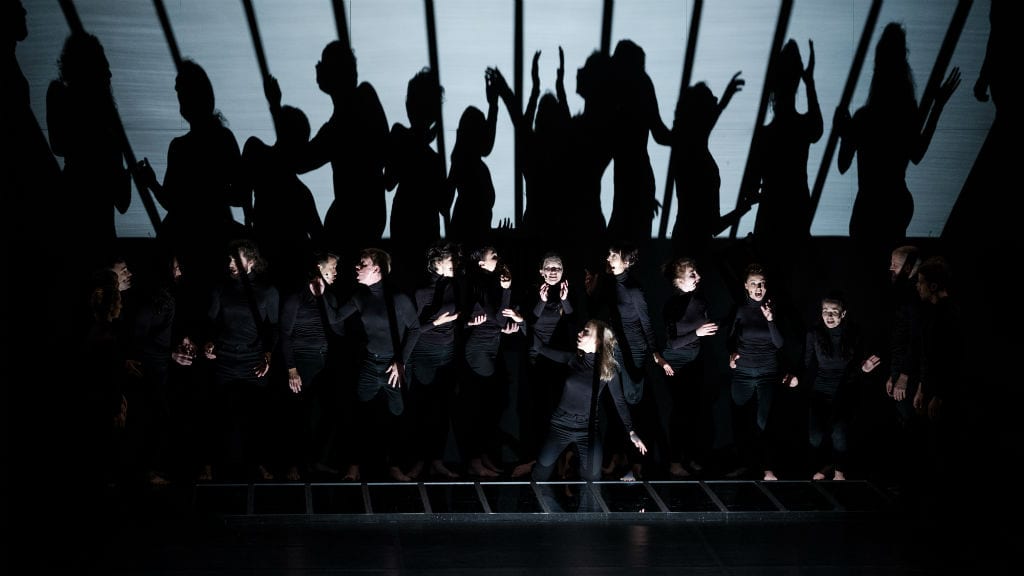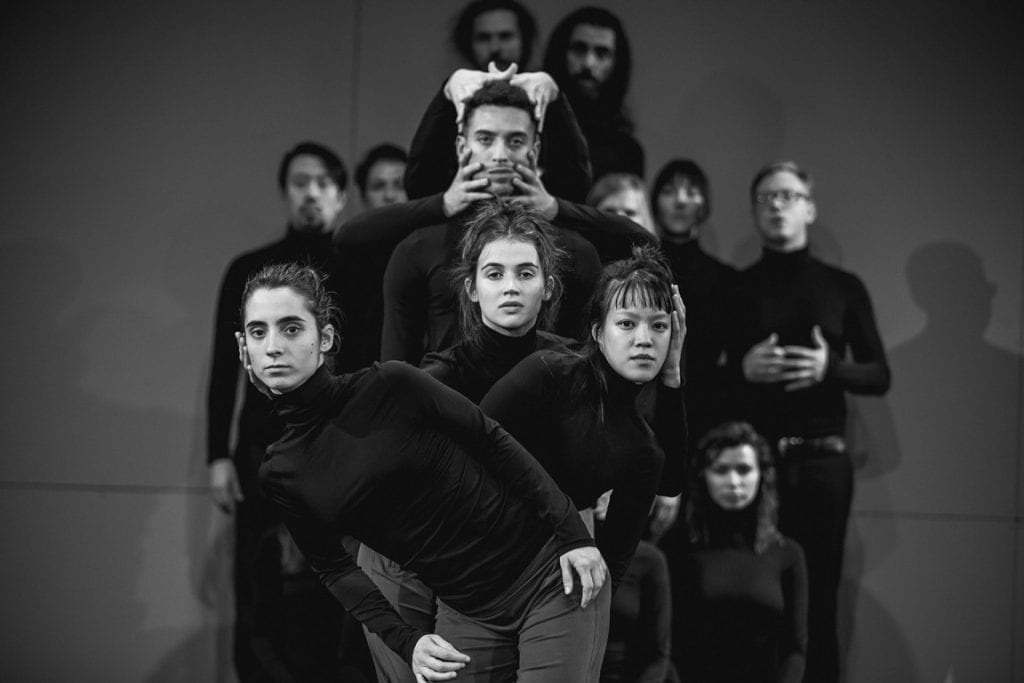The twenty-first edition of the International Shakespeare Festival in Gdańsk is taking place this year between 28 July and 6 August. The Teatr Szekspirowski was inaugurated in September 2014 and it has been functioning as a theatre by agency contract ever since. It hosts a variety of events and I am proud to say that in June it presented the Romanian Week.
The whole theatre – stage and auditorium – is a shapeshifter. There are 56 lifts on stage and the space can be moulded according to the wish of the director – from Italian box to protruding stage, from central stage to catwalk, from inversed space (the audience on stage) to… an Elizabethan stage! The roof can be opened and it thus creates an open-air space as in Shakespeare’s time. Likewise, as if by a conjuring trick, all the stall seats can be hidden beneath the galleries, thus making space for a ballroom. The auditorium counts 595 seats in the stall and galleries, but more people can be fit in at Elizabethan performances, during which “groundlings” stand and lean against the stage. Thus, this festival will spoil us with a wide variety of performing spaces, starting with the traditional Italian box.
The lifelong dream of Professor Jerzy Limon, the director of the Szekspirowski, was to re-create the 1635 Elizabethan-type theatre in Gdańsk (also known as the Fencing School), and Italian architect Renato Rizzi won the project competition and made it come true. This year the congress of the European Shakespeare Research Association (ESRA), in which I participated, was organised so as to overlap with the first few days of the festival. At the opening famous Belgian director Luk Perceval thanked God for people who dare to dream and achieve such wonders.
This year’s festival opened with a performance of the Song of the Goat Theatre entitled Island on 27 July (for ESRA members only) and on 28 July (for the general public). Founded in Wrocław in 1996 by Grzegorz Bral and Anna Zubrzycka, this company functioned under the name Tragon Theatre until 1998. Its current name commemorates the theatre’s first production – Song of the Goat – Dithyramb (Pieśń Kozła – Dytyramb, 1997), which was based on Euripides’ The Bacchae (The Bacchantes) and whose music was inspired from old songs from the Greek regions of Epiros and Crete, from Albania and – once again I am proud to say – Romania. This theatre focuses mainly on creating artistic expression through music and movement, and the text is sung rather than spoken. The performances are anchored in anthropological studies and voice training. For the past few years, the company has become international, as workshops are organised both in Poland and elsewhere – Birchwood, London, Manchester, Dublin, Taiwan and Singapore. The Song of the Goat Theatre is the only alternative theatre in Poland, and one of only two in Europe, which has a postgraduate study programme allowing actors to gain a Master of Arts certificate, as it is affiliated with the drama department of the Manchester Metropolitan University.
For Island, Grzegorz Bral claims to have been inspired by Shakespeare’s The Tempest. The performance opens with a few lines written by Alicja Bral about Prospero (the central character of Shakespeare’s play), and the programme informs the audience that in the interpretation of this company, the action of The Tempest takes place in the imagination of an old and demented Prospero, chained in his prison and betrayed. The programme does not say why he is imprisoned or how he has been betrayed. “Prospero’s imagination is poetic and magnetic. He creates all the characters that surround him, he is all of them at once and he does not see any of them at all. (…) The old man’s narrative is illogical, suggestive and cannot be easily described.” Thus, all the characters on stage are anonymous, not playing clearly defined parts.
During the performances at the Teatr Szekspirowski, besides Prospero’s two minute long opening line (the only spoken text in the performance, which was translated from Polish into English), no overtitles were provided. So we, the audience, did not have the opportunity of following the text of the songs while listening to the music and watching the choreography, and therefore practically no connection could be made with the Bard’s play. However, putting such filiation firmly aside, the show was a joy to watch.
The opening lines connect the title with various symbols, as Prospero’s eyes are islands of loneliness, and he terms each fragment of reality an island. He is called an old druid (as in Shakespeare’s play he is a magician), and his main concern is that “Everyone must survive”. At the end of this introduction, we are told that “Prospero died in his cell – happy. It was a good death.” We are left wondering, however, as this short text is written in the first person (and Prospero is referred to in the third person): “I met him in late autumn. I was despaired. Pain would stick to my soul, like leaves to the wet ground. I had no idea who I’d become.” The identity of the speaking voice is never revealed, so we ponder whether it can be that of Caliban (the monster in Shakespeare’s play), or of Ferdinand (the Prince of Naples who will become Prospero’s son-in-law) or of any one of us, human wrecks who need an encounter with life-preserving magic. The text seems to pay tribute to T S. Eliot’s style.
Once the text has been uttered, the floor literally goes to movement and sound. We are told in the programme that Prospero has been imprisoned for twelve years and he tells twelve musical poems. On the stage, in the absence of any represented Prospero, bodies interlock to suggest waves, which makes us think of Prospero’s crossing the sea and shipwrecking on the island.
The actors intone “Sophocles’ song” on lines 1115-1125 of Antigone (an invocation of Dionysus, god of the vine and wine) – a powerful piece that attempts to recreate the atmosphere of ancient Greek music, providing a strong rhythmic base for the movement. Sudden harsh, high-pitched, eerie sounds suggest the song of witches (a possible allusion to Sycorax).
Three couples (male-female, male-male, female-female) dance symbiotically as the song alludes to the introduction – “go to the other side of things, Miranda”.
The scenography is extremely simple, consisting solely of chairs and mirrors. The chairs are hung askew on walls suggesting the abnormality of life, while the mirrors are placed on the floor, lifted vertically and moved in various directions so as to cast reflections in the theatre. This magical effect goes hand in hand with the lyrics “My island does not exist.”
The movements are very simple at the beginning and, as the performance progresses, they develop into an ever more complex choreography that culminates with an Indian-like structure, a geometrical “tower” made of many bodies that signify one being.
One of the girls engages in a degraded version of pas de deux in which her articulations are fluid and her partner’s are not. The words “It flows from your skin” seem to illustrate her physical and spiritual state: she cannot stand by herself. She needs him as a prop. In a perhaps far-fetched interpretation, we may think of Miranda, Prospero’s daughter, who cannot think for herself without his support.
In the next number, another girl dances with positively loose joints, as if diseased.
All the actors wear unflattering black jeans and turtlenecks, as if in a world of despair no body can be beautiful. Towards the end of the performance, singing “I cannot choose to die”, they all hide behind the mirrors.
A slim, nimble figure is harnessed and swings from the ceiling as if bidding farewell, which makes us wonder if this might be the visual representation of the sprite Ariel set free.
Sound-wise, the actors intone a chant/drone/mantra, which creates a deeply esoteric atmosphere that somewhat belies Prospero’s final decision to abjure his rough magic.
Conferring symmetry upon the performance, Sophocles’ song is repeated in a visually inversed version (singers behind the dancers). In the last image, the shadows created by the light effects multiply the number of bodies, which movingly illustrates the idea that everyone must survive.
What is most noteworthy about this production is the beauty of the actors’ singing (in Polish, English and ancient Greek). The programme announces vocal polyphony, but it must be said that all the songs are harmonic, not polyphonic. The author must have meant that there are many voices on stage. But the styles are varied, including traditional Iranian chant.
Technically, the group works like a well-oiled machine. Artistically, it charms and bewitches, as we would expect Prospero’s wand to do. For those of you who are looking for a Shakespeare adaptation, this is not it. The performance is remotely related to The Tempest, if at all. But for those of you who are simply looking for art, this is a performance that creates catharsis.



